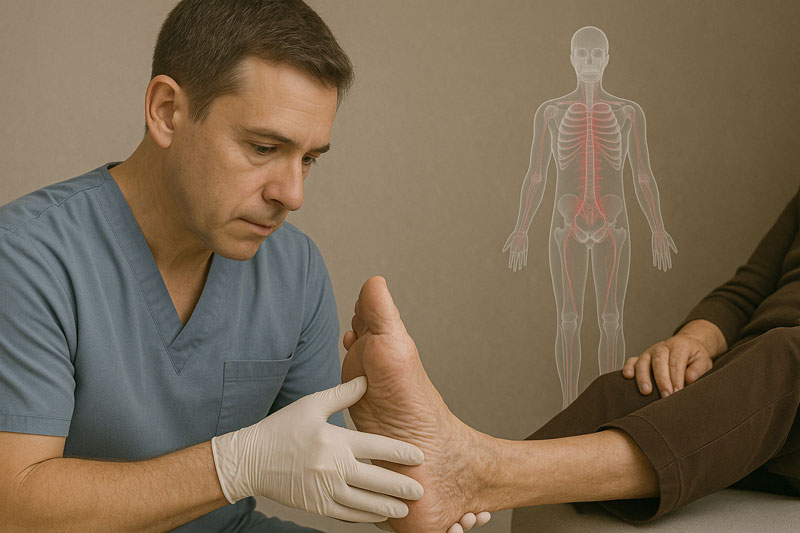Introduction
Stress fractures in the foot are tiny cracks in the bones caused by repetitive force or overuse. These injuries are common among athletes, military recruits, and people who increase their physical activity suddenly. Understanding the signs of stress fractures and knowing the appropriate treatment options are essential to avoid complications and ensure a full recovery.
What Are Stress Fractures?
Stress fractures are small, hairline breaks in the bone caused by repeated stress rather than a single traumatic event. Unlike acute fractures, stress fractures develop gradually due to repetitive overloading.
Common Causes of Stress Fractures in the Foot
- Overuse from activities like running, jumping, or marching
- Sudden increase in physical activity intensity or duration
- Improper footwear that does not support the foot
- Weak bones due to osteoporosis or nutritional deficiencies
- Structural abnormalities like flat feet or high arches
Signs and Symptoms of Stress Fractures
Early Warning Signs
- Mild pain during or after activity that improves with rest
- Localized tenderness or swelling over a specific area of the foot
- Slight bruising or redness in some cases
Progressive Symptoms
- Increasing pain that worsens during activity and may persist at rest
- Difficulty walking or bearing weight on the affected foot
- Noticeable swelling and tenderness over the fracture site
Diagnosing Stress Fractures
Medical History and Physical Exam
Doctors assess symptoms, activity levels, and examine the foot for tenderness, swelling, and deformities.
Imaging Tests
- X-rays: Often normal in early stages but used to rule out other injuries
- Bone Scan: Sensitive for detecting stress fractures early
- MRI: Provides detailed images of bone and soft tissue, useful for confirming diagnosis
Treatment of Stress Fractures in the Foot
Rest and Activity Modification
- Avoid activities that cause pain or put stress on the foot
- Use crutches or a walking boot to reduce weight-bearing if recommended
Pain Management
- Over-the-counter pain relievers like ibuprofen or acetaminophen can help reduce pain and inflammation
Immobilization
- In some cases, a cast or rigid boot may be needed to immobilize the foot and promote healing
Physical Therapy
- After initial healing, physical therapy can help restore strength, flexibility, and prevent recurrence
Nutrition and Bone Health
- Ensure adequate calcium and vitamin D intake to support bone healing
- Address any underlying bone health issues with medical guidance
When Is Surgery Needed?
Surgery is rarely required but may be necessary for fractures that do not heal with conservative treatment or if the fracture is displaced.
Preventing Stress Fractures
Gradual Increase in Activity
Increase exercise intensity and duration slowly to avoid overloading bones.
Proper Footwear
Wear shoes that provide adequate support and cushioning for your activity type.
Cross-Training
Incorporate low-impact exercises like swimming or cycling to reduce repetitive stress.
Maintain Healthy Nutrition
Adequate intake of calcium, vitamin D, and other nutrients essential for bone strength.
Conclusion
Stress fractures in the foot are a common overuse injury that requires early recognition and proper treatment to prevent complications. Paying attention to early symptoms, seeking timely medical advice, and following recommended treatment plans can lead to full recovery. Preventive measures such as gradual activity increases, proper footwear, and good nutrition are key to minimizing the risk of stress fractures.
Frequently Asked Questions (FAQs)
1. How long does it take for a stress fracture to heal?
Healing usually takes 6 to 8 weeks, but it can vary depending on the fracture severity and individual health.
2. Can I continue exercising with a stress fracture?
It’s important to rest and avoid activities that cause pain until the fracture heals.
3. What types of shoes are best to prevent stress fractures?
Supportive shoes with good cushioning and proper fit for your activity are ideal.
4. How can I tell the difference between a stress fracture and a bruise or sprain?
Stress fractures cause localized, persistent pain that worsens with activity and improves with rest, while bruises and sprains typically involve swelling and diffuse pain.
5. Are stress fractures common in people with osteoporosis?
Yes, weakened bones due to osteoporosis increase the risk of stress fractures.












